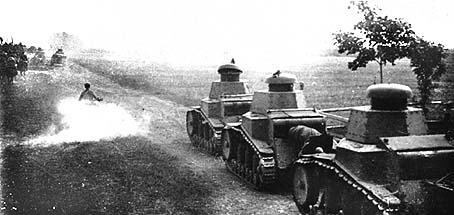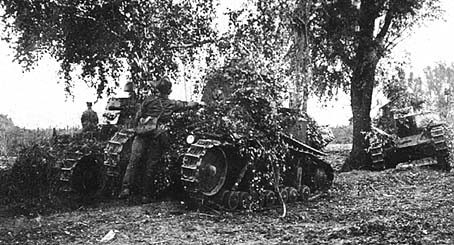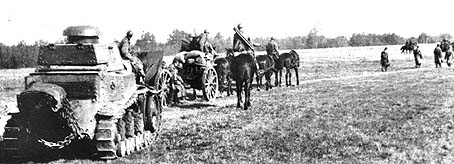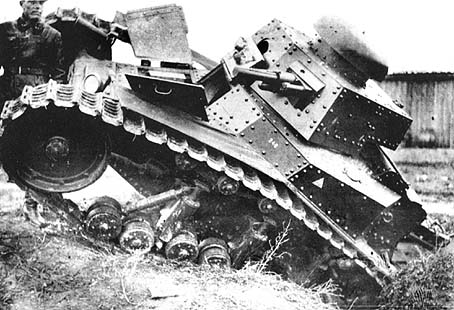| The MS-1 Small Escort Tank |
|---|
|
|

Service in the forces of the first Soviet tanks did not leave behind a large number of clear combat examples. Altogether some 959 T-18 tanks were built, of which 4 were handed over to the OGPU, 2 to the 4th Directorate, and 1 to the Military-Chemical Directorate of the RKKA. The remaining tanks were sent to tank battalions, regiments, and brigades of the combined arms formations that were being created, and as well to the regiments and brigades of the mechanised formations that were being formed in 1929. Escort tanks were actively utilized for combat training of troops (103 vehicles were made available to OSOAVIAKhIM and other military-technical training institutions). Thanks to these training opportunities early tankers of the RKKA became familiar with the nuances of operating in cooperation with infantry units, and artillery and infantrymen mastered a form of combat new to them - antitank defense. The first serious test for the T-18 was the large Bobruisk maneuvers of 1929, at which several commissions monitored the performance of the tanks. The tanks acquitted themselves well in the course of these maneuvers. Despite extremely difficult and grueling conditions of their use, almost all of the T-18s withstood the test. But there were countless minor technical breakdowns that the commission recorded in a single document. This list served as an additional stimulus for modernization of the tank that was undertaken in 1929-30. During this same year the tank took part in actual combat actions. This occurred in the course of the military conflict on the China-Eastern Railroad (KVZhD), which from the contemporary perspective has been classified as a local conflict. |

Russian Empire built the KVZhD during the years 1887-1903. In 1924 the two governments signed the Soviet-Chinese agreement in Peking, by which the KVZhD was considered to be a joint enterprise. However, in the opinion of V. K. Blyukher, the incident of the fall of 1929 in Transbaikal "was neither peace nor war, but only a conflict". Each of the sides participating in this conflict did not desire the interference of a third party, and any military operation in such conditions would have success only if it were prepared in secret and executed with total surprise, after which the verbal wrangling between diplomats could be dragged out for months. In the fall of 1929 the Transbaikal group of forces of the ODVA [Separate Far East Army] were prepared to deliver a lightning-like defeat on the Chinese Mukden Army in the area of Manchzhuria and Dzhalaynor stations and Dzhalaynor mines. For this purpose, opposing the Chinese grouping of 12-16 thousand men the Transbaikal group of the ODVA deployed 6091 infantrymen and 1599 cavalrymen supported by 88 guns of caliber 76.2mm and larger (not counting regimental weapons), 32 aircraft, 3 armored trains, and 9 T-18 tanks. (There were 10 T-18 tanks in the Chita area in the fall of 1929, one of which was heavily damaged during unloading and had been disassembled into parts for the repair of other tanks.) Organizationally, this group was comprised of the 21st Perm Rifle Division (in Chita), 35th Rifle Division, 36th Transbaikal Rifle Division, 5th Cavalry Brigade, Buryat-Mongolian Cavalry Division, a separate tank company, 6th Aviation Detachment, 25th Aviation Detachment, 26th Bomber Squadron, 18th Artillery Battalion of corps artillery, 18th Engineer Battalion (in Chita), and 1st Railroad Company. Command of the group was entrusted to S. Vostretsov under the general guidance of the ODVA, which was commanded by V. K. Blyukher. The Chinese erected field fortifications in the area of Dzhalaynor station. They covered the road to Abagaytuevsk with three lines of full-profile trenches, between which were constructed good shelters. These shelters had roofs made of rails and ties and were filled in with 1 metre of frozen soil. But these fortifications were weaker from the south, where there were two lines of trenches, and from the east where there was only a single trench line in places. The key to all of these positions in the area of Dzhalaynor station and Dzhalaynor mines was Hill 269.8, which covered the approaches to the station from the east (with the taking of this hill by a bypassing column the station fell). The Chinese anticipated the employment of tanks or armored cars on the axis of the main attack. They encircled their positions here with an antitank ditch 3-4 metres wide and 2.5 metres deep. A portion of the artillery was designated for firing in direct lay. A large portion of the infantry was equipped with grenades (the Chinese did not erect any multiple-row barbed wire obstacles as some authors have contended). |

The group commander, S. Vostretsov, underestimated the enemy and therefore did practically nothing to prepare his forces for battle. During the three-month standoff he did not even undertake aerial reconnaissance of the Chinese positions. As a result of this failure, during the course of the battles the Red Army soldiers encountered enemy fortifications in places where they did not expect them. Thus, until the very moment of the attack they believed that the antitank ditch was the first trenchline, and therefore the soldiers and tanks were not equipped with any mean to overcome it. By the efforts of the group commander secrecy was maintained to an absurd level, which led, for example, to the case where the commander of 36th Division for two hours before his unit's departure had to personally run across the frozen steppe in search of his lost ammunition trucks, to whom he had not issued a clear staging point. Taking advantage of moonlight, units departed on 16 November at 11 p.m. and began moving out to jumping-off positions. All roads and fields were covered with a layer of ice from the previous evening's precipitation. Orientation (navigation) was extremely difficult, the more so because the commanders lacked experience in conducting night tactical marches. Units that had been designated to bypass Dzhalaynor station became lost. One battalion, moving at the rear of the column, deviated off to the west from the intended route and fell under withering fire of Chinese machine guns, suffering heavy losses. Regrouping was accomplished too late and by the time it was completed the battalions had to go into battle without any kind of rest. Even up to the time of departure the tank company had not received any kind of order for battle, only its final destination. The tanks had not been topped off with fuel and were practically without ammunition. Three tanks did not have their machine guns mounted. The tank company commander did not have a map of the battle area. It is not surprising that during the night march the tank company became lost and only four tanks arrived at the destination. Here they were refueled and received up to 40 rounds (of a combat norm of 96 rounds). In accordance with the combat plan, the tanks were supposed to support the actions of 107th Rifle Regiment. The tanks that had become lost were not found before the beginning of combat actions. At approximately 1000 the 103d Rifle Regiment and 5th Cavalry Brigade began to attack the northern and southeastern sectors of the Dzhalaynor station defenses. Simultaneously the 107th and 108th Rifle Regiments attacked the enemy on the main axis. It turned out that these units practically did not have artillery support except their organic regiment artillery. It was laughable that comrade Vostretsov assigned a tank company to them (it was actually a platoon). During the attack on the intermediate fortifications the tanks put on a good show attempting to evade the fire of Chinese artillery. They developed too much speed and the Red Army soldiers could not keep up with them. But the objective was achieved and the fortification near hillock # 9 and "Zheleznaya" ("Iron") fell. Later, near noon, the tank unit that now comprised six tanks (two of the lost tanks had arrived at 11:50 a.m.) went into the attack at the main line of the western sector of the Chinese defense. Battalions of the 107th Rifle Regiment were thrown into the attack behind them, but the accelerating tanks suddenly halted in front of the antitank ditch. The soldiers moving behind the tanks, who lacked any makeshift means for overcoming the ditch, also stopped. Having exchanged dozens of fruitless shots with the Chinese, the tanks turned to the south and the sector of attack of 108th Rifle Regiment. Despite the good antitank defense here, the Chinese were unable to knock out a single tank because their artillerymen could not have been worse in their firing. The appearance of tanks did not incite panic among them - just surprise, according to recollections of the participants. The Chinese positions literally bristled with binoculars and telescope tubes. |

Of the tanks that fell behind, all that is known is that two of them got lost and linked up with their group in the evening. One tank fell out with a broken transmission. Two tanks reached the position of the 106th Sakhalin Regiment and, lacking any ammunition, just the same supported with their "tracks and fearsome appearance" the attack of the intermediate Chinese fortifications near Abgaytui intersection. Here the tank commanders operated with skill and the soldiers took shelter behind them. Two tanks were disabled in the course of the battle but one of these was repaired by evening. The combat actions on the following day also were not laid out clearly for the tank company. Eight machines supported the attack of 108th Rifle Regiment in the area of "Mother" and "Daughter" hillocks. The battle lasted almost three hours. The tanks attempted to assist the infantry, but were unable to do so until the antitank ditch was partially destroyed. Later several machines managed to penetrate into the Chinese positions. One was damaged by grenades but the remainder swept the trenches with intensive machine gun fire. The onrushing infantry consolidated the success. |

After the occupation of Dzhalaynor came the turn of the garrison of Manchzhuria station. The tanks again supported the 108th Rifle Regiment. Seven of them remained serviceable. Two could not be repaired. At dawn after an artillery preparation the tanks were hurriedly thrown forward, ignoring the mission of covering their own infantry. But here their appearance was apparently unexpected. The Chinese even ceased fire and looked in shock at these fantastic machines. The tanks crawled to the positions, conducting furious fire from machine guns. One of them came within reach of the objective when Chinese grenades flew toward it. Only the efforts of the onrushing Red Army soldiers saved the crew from death. The driver-mechanic was seriously wounded. One tank burst into the trench and got so stuck it had to be dug out after the battle. Another tank lost a track, which jumped off while the tank was negotiating the ditch. On the whole the activity of the tank company in the course of the KVZhD conflict was evaluated as satisfactory. Also noted was the insufficient training of the drivers, inability of the commanders to remain oriented on the terrain, and lack of communications between them. Firing from tank cannons demonstrated the unsuitability of the shells against field fortifications. The machine guns, which were more effective even from the perspective of morale, were of greater use. Desires were expressed to increase the caliber of the tank cannon, increase the number of machine guns, and improve the mobility, speed, and armor of the tank. But there were also complaints in the tank unit, for example, the report of the deputy chief of staff Lapin, who saw in the tanks only negative aspects and decried the "expenditure of the peoples' money on these toys". He preferred that more cannons, armored trains, and armored cars be produced. The significant theme that the old tanks had practically been used up was begun in 1938. Because the modernization of the T-18 that was conducted in 1938 did not yield the anticipated results, the matter of their future use became an acute issue. By the beginning of 1938 some 862 T-18 tanks remained of the 959 that had been built. The remainders had fallen into disrepair and were delivered to the scrap yard after the removal of all armaments and assemblies from them. 160 tanks of the Leningrad Military District that had worn out engines had been turned over to fortified districts in 1934-37 for the construction of DOTs (DOT means permanent fortification). The condition of the tanks that remained in units, and especially in training organizations, was horrible. A large part of them simply were scattered about on the territory of the military units with unserviceable engines, transmissions, and so on. A majority of these had been disarmed. There were no spare parts and repair was accomplished only by removing parts from one tank to repair the others. An instruction of the People's Commissar of Armaments of 2 March 1938 decided their fate: 700 T-18 and 22 T-24 tanks were to be turned over to fortified regions of military districts. There it was intended that unrepairable vehicles be used to create fixed firing points. It was recommended to use twin DA-2 machine guns, two DT machine guns, or the model-1932 45mm tank gun for arming of these new DOTs. The hulls of these machines, along with their engines and transmissions, were to be turned over for scrap metal. Tanks that could still move were partly rearmed with the type-1932 45mm tank gun and given to fortified region garrisons to be used as mobile firing points. |

The majority of the T-18 tanks were not around at the beginning of the Great Patriotic War. Approximately 450 tank hulls and about 160 tanks that could still move under their own power were able to serve in the defense of the USSR. It has been confirmed that in 1941 the Osovetskiy Fortified Region, which occupied approximately 35 kilometres of frontage, had 36 armored turret mounts (including those from the T-18) equipped with 45mm tank cannons, and also two tank companies (the 1st, consisting of 18 T-18 tanks in the Kol'no area, and the 2d, of 18 T-18 tanks in the Belyashevo area). In June 1941 the 2d Company successfully fought with German combat vehicles, a significant portion of which also were light tanks, armored cars, and armored troop transporters. Vladimir-Volynskiy Fortified Region was supported by elements of the 87th Rifle Division, which did not have any tanks. However, during the German attack on 22 June, the division was supposed to receive five T-18 tanks at afternoon at Ustilug station. Because these tanks did not have armaments or engines, it was intended that they be given the simplest gadgets for installation of a DP light machine gun and by 23-24 June placed on the terrain as immobile firing points to cover dead space, defiles, ravines, and so on. The best location for such DOTs was on the reverse slopes of hills. It is known that the tanks were received and set up, but details about their combat employment are not known. Somewhat more information is known about the T-18 in the 9th Mechanised Corps. On 23-29 June 1941 the mechanised corps participated in the large tank battle in the area of Rovno - Broda - Lutsk, advancing on Kleist's tank group from Lutsk toward Dubno. By 29 June the corps had suffered great losses in equipment. To replace these losses a battalion of tanks came forward from Sarny consisting of the following: a company of 12 T-26 tanks, a company of 15 mixed T-26 and BT tanks, and a company of 14 T-18 tanks with a T-26 command tank. This force also suffered losses. A summary regarding the composition of the mechanised corps on 2 July notes the presence of two T-18 tanks, one of which was unserviceable. The Minsk Fortified Region also had T-18 tanks. On 23 June 1941 a T-18, armed with a 45-mm gun without engine was established as a BOT [armored firing point] to protect the bridge across the River Drut (in the area of Belynichi). The crew of this tank, artillerymen Sergeant Gvozdev and Private Lupov, defended the bridge over the course of four hours and destroyed three German tanks, one armored transporter, and several wheeled vehicles, and also dispersed up to a company of infantry. As a result of their efforts they were put in for award of the Order of the Combat Red Banner. The last of the known facts regarding the combat fate of the T-18 relates to the battle for Moscow. Nine T-18 tanks participated in battles in the winter of 1941-43 as part of the 150th Tank Brigade, and remained accounted for in documents until February 1942. |
Translated by:
James F. Gebhardt Sources: A.Beskurnikov, M.Svirin, "Pervye Sovetskie Tanki" Armada #1; A.Beskurnikov "Pervij Serijnij Tank Malyi Soprovozhdeniya MS-1", Arsenal-Press, Moscow, 1992. |